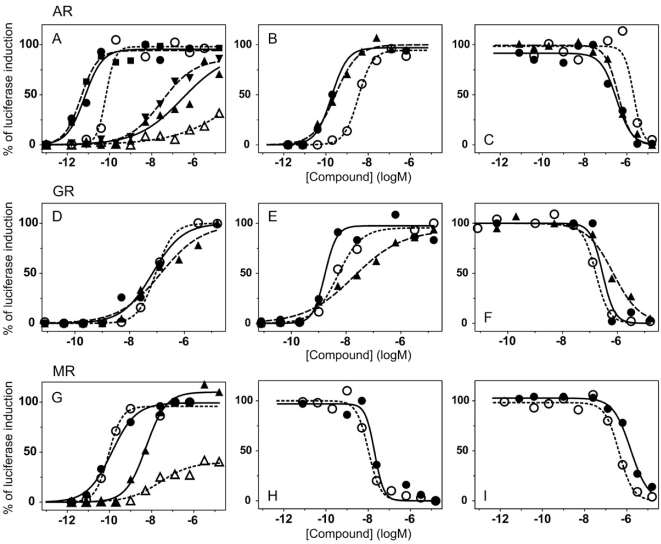Fig. (3).
Transcriptional response of AR, GR and MR luciferase reporter cell lines to selected compounds. Different responses of AR, GR and MR luciferase reporter cell lines to selected compounds were obtained by the incubation of the cells with increasing concentrations of tested compounds for 20 hours. At the end of this time luciferase activity was measured. (A) U2OS-AR/3xGRE cells were tested with dihydrotestosterone (●) and E2 (▲); U2OS-AR/MMTV with dihydrotestosterone (■) and E2 (▼); U2OS-AR-LBD/9xGal4UAS with dihydrotestosterone (○) and E2 (∆). (B) Agonistic response of U2OS-AR/3xGRE (●), U2OS-AR/MMTV (▲) and U2OS-ARLBD/ 9xGal4UAS (○) reporter cell lines to testosterone. (C) Antagonistic response of U2OS-AR/3xGRE (●), U2OS-AR/MMTV (▲) and U2OS-AR-LBD/9xGal4UAS (○) reporter cell lines to nilutamide in the presence of 0.05 nM, 0.05 nM and 1 nM dihydrotestosterone respectively. U2OS-GR/3xGRE (●), U2OS-GR/MMTV (▲) and U2OS-GR-LBD/9xGal4UAS (○) reporter cell lines were tested with cortisol (D) and betamethasone (E) in the agonist mode and with cyproterone acetate in the presence of 5 nM dexamethasone for all of the reporter cell lines (F). (G) U2OS-MR/MMTV reporter cell line was tested with aldosterone (●) and dexamethasone (▲); U2OS-MRLBD/ 9xGal4UAS with aldosterone (○) and dexamethasone (Δ). Antagonistic response of U2OS-MR/MMTV (●) and U2OS-MRLBD/ 9xGal4UAS (○) reporter cell lines to spironolactone (H) and to dihydrotestosterone in the presence of 1 nM aldosterone for all of the reporter cell lines (I).

